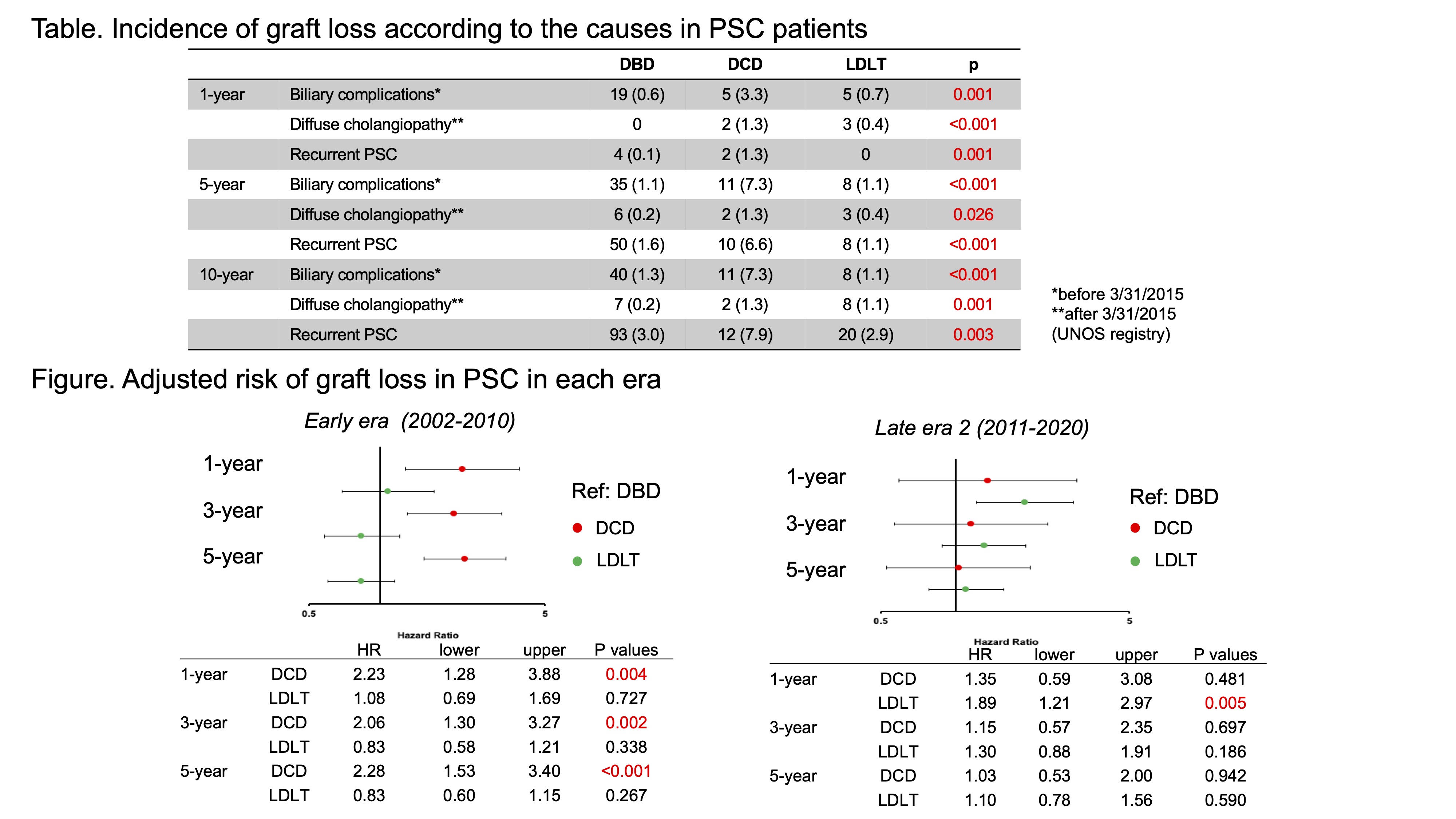Long-term Outcomes of Donation After Cardiac Death and Living Donor Liver Transplant for Primary Sclerosing Cholangitis: An Analysis of UNOS Registry from 2002-2020
Transplant and Hepatobiliary Surgery, Henry Ford Hospital, Detroit, MI
Meeting: 2021 American Transplant Congress
Abstract number: 1149
Keywords: Donors, marginal, Liver transplantation, Living donor, Primary sclerosing cholangitis
Topic: Clinical Science » Liver » Liver: MELD, Allocation and Donor Issues (DCD/ECD)
Session Information
Session Name: Liver: MELD, Allocation and Donor Issues (DCD/ECD)
Session Type: Poster Abstract
Session Date & Time: None. Available on demand.
Location: Virtual
*Purpose: Use of donation after circulatory death (DCD) grafts is a reported risk factor for worse outcomes after liver transplant (LT) for primary sclerosing cholangitis (PSC) due to increased biliary complications. However, outcomes comparing DCD, donation after brain death (DBD) donors, and living donor LT (LDLT) have not been fully studied in a recent cohort. This study aims to assess outcomes of LT for PSC with each graft type.
*Methods: Using OPTN/UNOS data, we analyzed LT patients with PSC or primary biliary cholangitis (PBC) between 2002 and 2020. Patients with status 1A, multi-organ or re-transplant were excluded. One, 5, and 10-year graft survival (GS) were compared between PSC and PBC groups. Next, outcomes were compared between DBD-LT, DCD-LT, and LDLT in each group. In PSC, the three types of donor grafts were compared for cause of graft loss. Finally, transplant outcomes were analyzed in early era (2002-2010) and late era (2011-2020). Risks were adjusted by recipient variables.
*Results: 3,946 PSC and 2,675 PBC patients were eligible. Among PSC patients, 3,099 (78.5%), 151 (3.8%), and 696 (17.7%) received DBD-LT, DCD-LT and LDLT. One, 5, and 10-year GS were similar between PSC and PBC. In PSC, DCD-LT had significantly higher risk of 1, 5, and 10-year graft loss than DBD-LT (1-year: HR 1.87, p=0.007, 5-year: HR 1.74, p=0.001, 10-year: HR 1.60, p=0.003) whereas LDLT had similar risks of 5 and 10-year graft loss. In contrast, outcomes were comparable between donor types in PBC. As a cause of graft loss in PSC, DCD-LT had a significantly higher incidence of biliary complications and PSC recurrence than other graft types (Table). In DCD of PSC, the risk of 5-year recurrence was relatively higher in early era than in late era. 16.5% of DCD-LT lost grafts because of PSC recurrence or biliary issues vs 4.5% in DBD-LT and 5.1% in LDLT. Incidence of re-transplant was highest in DCD-LT (DCD-LT 18.5% vs DBD-LT 10.2% vs LDLT 10.6%, p=0.005). This finding was more prominent in early era whereas the risk of 3 and 5-year graft loss was similar among all graft types in late era (Figure).
*Conclusions: In PSC patients, the outcomes of the use of DCD grafts has improved over time although it was associated with worse post-transplant outcomes because of relatively higher recurrence and biliary complications in the earlier era. This finding was not seen in PBC. LDLT had similar outcomes to DBD-LT. The use of DCD grafts is an option for PSC with appropriate donor selection.
To cite this abstract in AMA style:
Kitajima T, Nagai S, Ivanics T, Shamaa T, Collins K, Rizzari M, Yoshida A, Abouljoud M, Moonka D. Long-term Outcomes of Donation After Cardiac Death and Living Donor Liver Transplant for Primary Sclerosing Cholangitis: An Analysis of UNOS Registry from 2002-2020 [abstract]. Am J Transplant. 2021; 21 (suppl 3). https://atcmeetingabstracts.com/abstract/long-term-outcomes-of-donation-after-cardiac-death-and-living-donor-liver-transplant-for-primary-sclerosing-cholangitis-an-analysis-of-unos-registry-from-2002-2020/. Accessed January 5, 2026.« Back to 2021 American Transplant Congress

